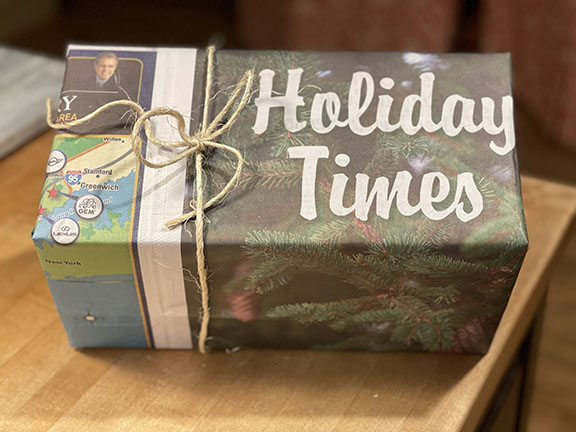
By Jody Sackett, Rumson Environmental Commission
The holiday season can be the “Clash of the Titans,” with so many contrasting expectations. But whether you prefer elaborate traditions or modern streamlining, sustainability is the popular new buzzword for the holidays.
From Thanksgiving through New Year’s Day, household waste increases by over 25%, as gift wrap, Christmas trees, excess packaging and food waste contribute over a million tons to modest roots, but a few simple ideas can reduce this impact.
Sustainability improves the quality of our lives, protects the Earth and preserves natural resources for future generations. Recognizing that lifestyle choices impact the environment, it makes sense to strive for a sustainable holiday season. Even if you only implement one idea here, you’re still helping the planet.
Here’s how:
Basic Sustainability Principles. Evaluate your needs before even starting to shop, to avoid unnecessary and impulsive purchases. Buy local to support your community and reduce carbon emissions. Buy durable so there’s less waste. Buy products made of recycled materials, with sustainable design and energy efficiency. Avoid needless packaging which takes up landfill space for decades. Batteries end up as environmental hazards, so look for gifts that don’t require them. Reduce your carbon footprint and gas costs by online “window shopping” and purchasing from as few different places as possible.
Buy Less Stuff. Assess whether you really need to give a gift in the first place. Studies show over half of recipients get gifts they don’t even want, and millennials especially prefer experiences over things. Reduce your gift list by using the Secret Santa approach to limit whom you need to buy for. Avoid gifting pressure by purchasing utterly unique intangible experiences to give the gift of learning and adventure, reduce clutter and eliminate waste. You’ll also be supporting important local facilities. Consider buying fun experiences like Broadway or local theater tickets, cooking lessons at community colleges, interior design gift cards, zoo or aquarium admissions, digital streaming subscriptions, gym passes, music lessons online or from a local teacher, Escape Room gift cards, camping or park passes, fortune-telling sessions and restaurant gift card packages, kayaking trips or microbrewery event tickets.
Alternative Gift Ideas. Make a date to share a meal, a drink or movie together instead of purchasing a present. Don’t underestimate the value of your company – you wouldn’t be friends if you didn’t enjoy spending time together. Donate to a favorite charity like the SPCA, or perhaps an interactive nonprofit. KIVA gift cards for curated microloans allow the recipient to decide which borrowers they want to support, in what country, for how much money, and for which purposes (from education to business-building). Heifer International gifts enable the recipient to give a flock of chickens, a cow, or even a drinking well to a needy international family. DIY gifts like flavored liqueurs, a homemade ornament, holiday cookies or nuts, dog biscuits, homemade cereals or snack mixes in glass canning jars, or even a framed letter explaining why you love and admire the recipient, are always appreciated. Colorful candles are simple to make by just rolling up sheets of beeswax around a wick, a perfect gift for Hanukkah.
Re-Gift. It’s not a crime or a sin to share a new present you received but won’t use with someone who would like it – it’s more sustainable that way. If you are hesitant, host a fun regifting party that requires guests to bring only nice unwanted new presents that they won’t be using. Presto! You’re done with your book club or tennis group gift list.
Gift Wrapping. If you need an excuse to simplify your gift wrapping, here it is. A Yale study found that nicely wrapped packages raised expectations for the gift inside and increased the risk of the recipient being disappointed, like giving a Walmart gift card in a Tiffany box. Gift wrap and bags add four tons of landfill waste each year, and gift wrap often can’t be recycled because it is made of low-fiber paper, laminated and shiny, has foil, or has dyes and other unrecyclable designs. Instead, make it easy on yourself by using eco-friendly and recycled materials such as old maps, newspaper comics or leftover blueprints from your local planning board. Decorate plain brown craft paper and bags with your kids or host a cocktail party (maybe Skype with distant friends) while creating holiday wrap and personalized gift bags together. Furoshiki, the Japanese art of cloth gift wrapping, uses just squares of cloth to cleverly wrap everything from boxes to wine bottles. By using upcycled materials like pretty scarves, leftover fabric, dishtowels, old tablecloths or Goodwill shirts, you’ve hit the environmental and artistic jackpot. Use seed paper, which contains embedded plantable seeds, for gift tags.
Decorating. Use LED instead of incandescent lights and you’ll use 95% less energy (more savings with solar). Timers will automatically turn off your lights at night, which is cheaper, better for the environment and, honestly, who needs lights at 3 a.m.? Make your own centerpieces and decorations with pinecones or greens found in your yard. Homemade tree ornaments crafted with photos (maybe glued to a seashell and tied on with a ribbon) preserve memories and will be cherished for years. Avoid plastics, which take decades or centuries to decompose. Host a group decorating party by collecting and using natural items scavenged from your yard, such as pine branches and pinecones, sprigs of boxwood, branches with holly berries, and tiny alder cones. Don’t use glitter – it’s often made from PET plastic and takes a century to degrade either in landfills or in our precious rivers when it’s washed down the drain. No need for artificial room scents when you can simply poke fragrant clove buds into sweet clementines, as it gives off a holiday scent while it dries.
Start New Family Traditions. Now is the perfect time to create sustainable family traditions to emphasize your eco-values. It can be as simple as constructing a Grateful Tree with a branch from your yard – guests write what they are thankful for on construction paper leaves and hang them on the tree – to help us realize how much we already have. Stretch your legs and go for a birding walk together, using apps like iNaturalist or Merlin to identify birds you hear and see. Even little ones love making simple pinecone-and-birdseed peanut butter bird feeders to hang in trees as winter gifts to your backyard wildlife. Bad weather? Have a family jam session using the Garage Band app on electronic devices, so everyone can participate regardless of talent.
Hanukkah. For your menorah, use vegan or eco-friendly candles, which contain natural ingredients instead of the petroleum-based paraffin ones with synthetic chemical ingredients for color and scent that can be released when burned. Beeswax, canola or coconut wax are organic and clean-burning. Use a menorah made of recycled materials or handcrafted by a local artisan. Buy healthy and environmentally sound organic latke ingredients like potatoes, onions, oil or sour cream, and make your own applesauce from organic apples. Finally, use the eight days of Hanukkah to implement eight Days of Action. As part of the menorah lighting each night, commit to being more environmentally sustainable by having all family members identify at least one way to achieve that goal. Perhaps instead of giving chocolate gelt, have the family choose a charity they’d like to support with real money.
Live vs. Artificial Christmas trees. The answer to this debate is really up to you. Artificial trees come primarily from China and are made from plastics, although lead-stabilized PVC content has been reduced. They cannot be recycled, take literally centuries to degrade, and the manufacturing and distribution process creates harmful petrochemical and carbon emissions. However, fake trees are good because they’re reusable year after year, which means fewer real trees need to be felled and trucked around the country. A 2007 study found an artificial tree would have to be used for at least 20 years before its carbon impact fell below that of a live tree, so be prepared if you choose this option. Real trees provide oxygen, air filtering, soil protection, wildlife habitat, carbon storage, and can be recycled, and ideally, sustainable farming plants more trees than are cut down each year. However, it takes a lot of fuel to cut them and bring them to you, accelerating carbon emissions.
So that’s it: your game plan for having a sustainable holiday and making sure you – and the planet – have a truly marvelous season. Every single effort contributes mightily to making the world a better place. What a wonderful and lasting gift!
The article originally appeared in the December 8 – 14, 2022 print edition of The Two River Times.














